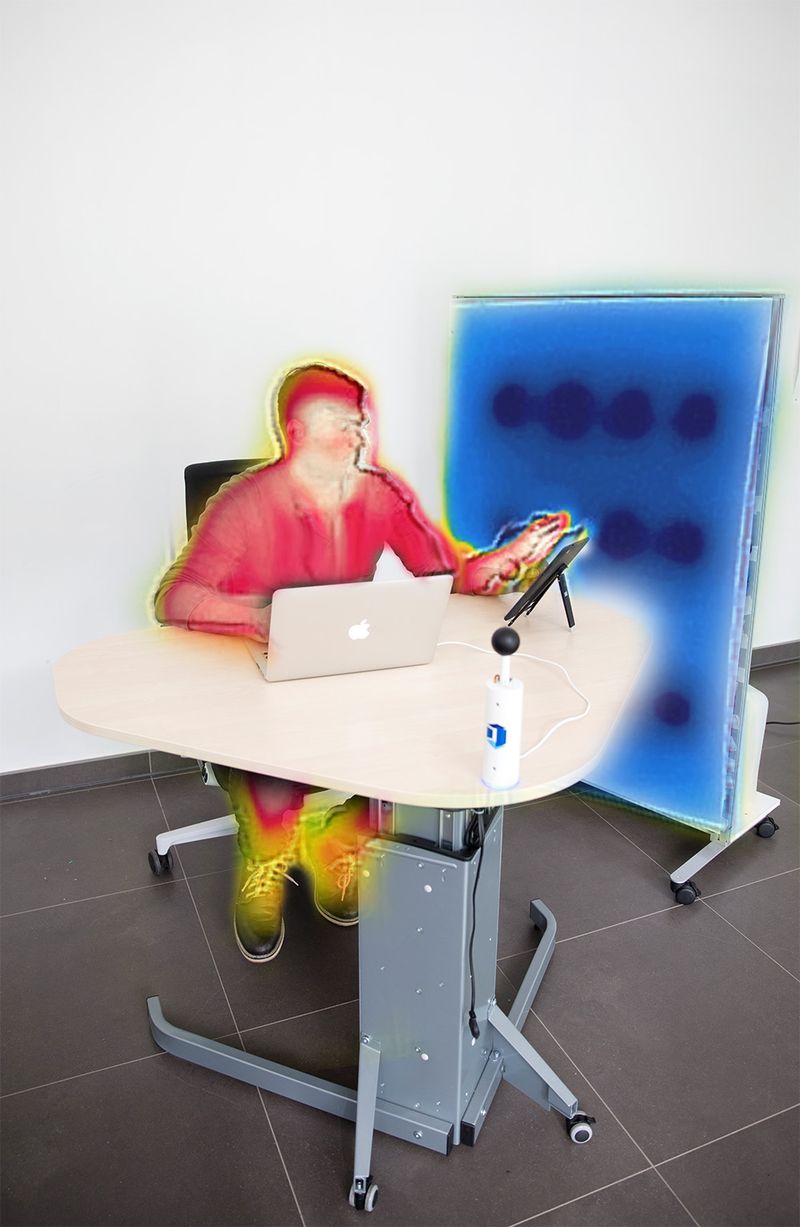
Thecla – ThermoElectric CooLing partition with Active heat storage
| Duration | 10/2015 - 10/2019 |
| Responsible | Prof. Dr.-Ing. Sabine Hoffmann |
| Team | Mathias Kimmling, Sabine Hoffmann |
| Project type | Doctoral research project |
The thermally activated partition is a development in the field of personalized environment. These are local devices for user-controlled cooling or heating to increase individual thermal comfort.
Thecla – Thermoelectric cooling partition with active heat storage – is a prototypical development of a movable partition, which is equipped with Peltier elements as thermoelectric coolers (TEC). It can be placed individually in the proximity of the workplace, where the partition’s cool surface increases the radiative heat loss of the occupant. Especially in hot environments like an overheated office in summer, this effect is perceived as very pleasant. The waste heat evolved within the TEC is transferred to a phase change material (PCM) heat storage on the rear side of the partition, which can be recovered to solid state actively or passively during nighttime. The process can be reversed for individual heating at any time.
A first prototype (Thecla 1) with Peltier elements showed the expected reduction of the subjects’ thermal sensation. This represents a successful implementation and a proof of concept. A second prototype (Thekla 2) with integrated heat circuit and storage was used for the thermodynamic examination and design of the system.
Based on this experience and data, two final prototypes (Thecla 3) with PCM were built in 2018 for application in user studies. The thermally active surface is divided into three zones, which can be controlled independently via an app. Comprehensive sensor technology in the partitions allows precise logging of the ambient and operating conditions and provides the necessary data for the final evaluation of the overall energy balance. User behavior during operation is recorded and thermal sensation and thermal comfort are continuously queried as important user feedback.
The simulation-based analysis of the system's energy balance, together with the results of the human subject study, forms the basis for the final evaluation of the approach. The valuation is expected to be completed in 2019.
Publications:
Kimmling, Mathias and Sabine Hoffmann. 2017. "Influence of PV-powered thermoelectric surfaces for user-individual radiative cooling on the cooling energy demand of buildings." In Proceedings of the 11th Nordic Symposium on Building Physics (NSB), Trondheim, Norway, June 2017. access on ScienceDirect
Kimmling, Mathias and Sabine Hoffmann. 2017. "Preliminary study of thermal comfort in buildings with PV-powered thermoelectric surfaces for radiative cooling." In Proceedings of the Improving Residential Energy Efficiency International Conference (IREE), Wollongong, Australia, February 2017. access on ScienceDirect
Kimmling, Mathias and Sabine Hoffmann. 2016. "Development of a PV-powered thermoelectric partition for user-individual radiative cooling in office buildings." In Proceedings of the 5th Indonesia renewable energy and conservation energy summit (IRES), Jakarta, Indonesia, September 2016. access on figshare



